We believe homelessness is the region’s most urgent ongoing issue, requiring thoughtful, decisive and timely action and most importantly political will.
We have established this scoring system in order to publicly highlight tangible, positive action and to call out shortcomings of elected leaders for addressing homelessness throughout San Diego County. It is compiled and organized by the Lucky Duck Foundation, which meets weekly to follow facts, collaborate with and survive generations of politicians, and apply sound business principles to fund, activate and lead high-impact programs designed to immediately help those suffering from homelessness.
The purpose is to showcase what is working so it can be replicated, and what is not working so it can be corrected or avoided. Strong actions that drive progress will earn “Shamrocks,” while ineffectiveness and inaction will earn “Shipwrecks.”
In special cases, we are awarding a Shamrock to non-profit organizations, businesses or individuals that demonstrate meaningful innovation, collaboration and progress in support of San Diego’s unhoused neighbors. Programs and initiatives that have the potential for scale and replication will receive additional consideration.
Particular consideration is given to tangible actions by elected leaders and their jurisdictions to:
The Lucky Duck Foundation, in partnership with the “Tuesday Group,” studies homelessness daily and meets weekly to determine how the private sector and philanthropy can most meaningfully accelerate change. We look to collaborate with elected leaders along with the region’s service providers, business community, and philanthropy to identify and implement high-impact programs. This scoring system is designed to highlight tangible, difference-making programs and action, and call out failures, missteps and missed opportunities of San Diego County’s elected and community leaders and their cities. Strong actions that drive progress earn “Shamrocks,” while failures and ineffectiveness receive “Shipwrecks.”




The City of San Diego has earned four Shamrocks and four Shipwrecks (expand to see details)
The County of San Diego has earned three Shamrocks and two Shipwrecks (expand to see details)
1. Underwrite the cost of purchasing 25 pallet homes; under the right circumstances, and, provided government contributes their fair share.
2. Underwrite the cost of purchasing and erecting a Sprung Structure bridge shelter to quickly shelter hundreds of people; under the right circumstances, and, provided government contributes their fair share.
3. Stand poised and ready to work with each City as well as the County and State to find ways to activate underutilized government properties, such as the old central library, to address homelessness.
4. Provide food & water to unsheltered homeless, delivered by outreach workers . This ongoing effort reaches approximately 1,000 people daily and has distributed well over 1,400,000 meals since launching in response to the pandemic. Per feedback from outreach workers, 97% say the food & water is life-saving and 85% say they have more positive interactions with individuals living unsheltered as a result. We are glad to increase the reach of this program by providing more food and partnering with additional outreach teams throughout the region. Learn more here.
5. Fund region-wide employment & job training opportunities as well as access to technology and education for individuals experiencing homelessness; LDF has invested more than $2 million in support of this effort. Learn more here.
6. And several other steps including but not limited to: convening San Diego’s research institutions to research homelessness; participating in Governor Newsom’s philanthropic working group on homelessness and housing; working to push collaboration in partnership with the Regional Task Force on Homelessness; supporting the Taxpayers Educational Foundation’s “Public Regional Outcomes Standards” Board; regularly hosting homeless symposiums with key stakeholders to instigate progress and collaboration; and funding, activating and leading other high-impact programs designed to make an immediate impact.





Personal or corporate checks can be made out to:
The Lucky Duck Foundation
5675 Ruffin Road, Suite 100
San Diego, CA 92123
These funds are highly popular among individual donors because of the ease of administration and potential tax savings from donating via a DAF.
Strategies to save big on taxes, such as Charitable Remainder Trusts, bundled donations, and donations of appreciated stock, IRA, real estate, and estates.
Leave a lasting legacy by including the Lucky Duck Foundation in your estate planning.
We offer turnkey peer-to-peer fundraising so you can create your own fundraising page and invite your friends and family to support the Lucky Duck Foundation and its programs.
There are many ways your organization can get involved and support community giving and volunteering.
We’ve partnered with LNDRY, a premier laundry service in San Diego, to pick up your gently used clothes donation (for free!) to help homeless employment and education-seekers look and feel their best!
Enjoy premium craft coffee with a purpose. Our coffee partner, Tower Roasting Co., provides 100% organic fair trade coffee while helping to prevent and reduce homelessness in San Diego by donating 30% of every sale.
Join our newsletter to stay informed about the Lucky Duck Foundation’s programs and to see how your donations are making a difference.
When you subscribe to our newsletter, we will DONATE A PAIR OF BOMBAS SOCKS on your behalf, in partnership with Bombas Socks.
5675 Ruffin Road, Suite 100,
San Diego, CA 92123
The Lucky Duck Foundation is a 501(c)(3) nonprofit organization. Tax ID: 20-3324885
© 2025 All Rights Reserved.
SHIPWRECK 5/30/23: Santee City Council
For shunning the opportunity to have tiny homes to provide shelter for people living along the riverbeds and issuing citations to people in homeless encampments while offering zero shelter beds. Issuing citations without offering a plausible and humane pathway off the streets is a waste of time and government resources. It is also not an effective use of law enforcement, which is historically very effective at connecting unsheltered neighbors to shelter and other resources to help end their homelessness. Citing people who do not have resources to pay the fine while offering them no place to relocate is ineffective and unpractical
SHIPWRECK 2/5/24: Escondido’s mayor should welcome help instead of fighting it.
We are reliably informed that Escondido Mayor Dane White plans to oppose a proposal by San Diego County Supervisor Terra Lawson-Remer to explore whether five or more county-owned properties can be used for temporary housing, safe parking, shelter, or other emergency relief for the homeless. Four of the properties are in San Diego, while one is about 2 acres in Escondido near downtown at 620 East Valley Parkway. The proposal is scheduled to be discussed at a Board of Supervisors meeting Tuesday, Feb. 6.
The proposal is modeled on the 150-bed Rosecrans emergency shelter, which was built on county property in the Midway District in partnership with the City of San Diego and the Lucky Duck Foundation. Opposing this idea at such an early stage is unwise, to put it mildly. The Escondido site is easily accessible with utility and sewer service in place. If approved by the Board, Supervisor Lawson-Remer’s measure could offer county funding for site development, installation of sleeping cabins, and other infrastructure. In exchange, the city or nonprofit that runs the center would be responsible for ongoing costs.
It seems like a pretty sweet deal, especially as the state just donated 100 Pallet Shelter cabins to the county. And Escondido is struggling with a major budget deficit, leaving officials with hard choices ranging from laying off police and firefighters to closing libraries and its arts center.
Mayor White campaigned in 2022 on getting homeless people off the streets of Escondido. Instead, he voted to kill funding for the Haven House shelter run by Interfaith Community Services, a nonprofit that’s been helping the poor for decades. White objected that Interfaith accepts homeless clients – and funding – from other North County cities.
The mayor wants a city-run shelter that’s somehow limited to those who lived in Escondido before they lost housing. And Mayor White says that accepting county help will force Escondido to accept the needy from surrounding cities. He’s wrong on this – the Board of Supervisors hasn’t even made the land available or asked for proposals, let alone decided who gets into the resulting housing.
And Mayor White may be badly misreading his constituents: 82% of likely voters believed San Diego County government should play a major role in addressing homelessness, while 84% believed city-owned vacant buildings (and presumably properties) should be used for inclement weather shelters, according to a poll commissioned in 2020 by Lucky Duck. That was three years ago. The public has even less patience with government inaction today.
Homelessness is a regional tragedy that needs regional solutions. But fair enough – if Escondido’s mayor wants to build a city-run shelter, that’s more beds for people in need. Yet he needs money the city doesn’t have, on land that hasn’t been identified. Years from now, the county plans to develop affordable housing on its Escondido property. Until then, emergency housing can be installed quickly, for pennies on the dollar compared to new construction. Doing it alone is a recipe for a worsening crisis of compassion, health, and public safety in North County.
Is the real agenda to chase the homeless into other cities? Tellingly, White is also working on a camping and parking ban – without first providing a safe place to house the people this would displace. It’s too early to know if the county will agree to provide its property and funding. We sincerely hope Mayor White changes his mind about opposing assistance before it’s even offered.
SHIPWRECK issued 5/30/23: County Supervisor Jim Desmond & Coronado Mayor Richard Bailey
For criticizing and ultimately saying “no” to the plan to pursue Homekey funding from the state to purchase nearly 500 housing units while not providing ideas or alternative strategies that would help people end their homelessness. It is much easier to say “no” than it is to develop a plan that will reduce homelessness. Sending unsheltered people to another city is not an appropriate or sustainable response for any city. Moreover, it places the burden and cost on other cities. Each of the 18 cities within San Diego County must do its fair share within its own city limits and budget to reduce homelessness and provide appropriate services and shelters.
Correction: a prior version of this Shipwreck stated that Mayor Bailey touts Coronado as having solved homelessness. While some media outlets stated that Mayor Bailey and Coronado had solved homelessness, Mayor Bailey has not corrected them but he has also not formally made this claim.

NEW SHAMROCK 8/18/25: For buying a massive, 12-bedroom home to serve as new transitional housing for homeless youth. The City of Vista is making the home available to Urban Street Angels, who will secure additional funding through philanthropy and the County to operate the residence. The Vista City Council unanimously approved the purchase of the property, and deserves a shamrock for their efforts to meaningfully address youth homelessness. The Lucky Duck Foundation is providing the lead gift to activate the home, among other philanthropic support. This is a great example of local government proactively partnering with service providers and a local foundation to make a difference for those in need.
SHAMROCK 12/8/22: County of San Diego’s funding for shelters & the Cities who pursued it. San Diego County’s commitment to make $10 million available to all 18 cities throughout San Diego County to increase shelters provided much-needed funds to add urgently-needed beds. The cities of San Diego, Oceanside, and Vista pursued and secured these funds because of their plans to add immediately available beds. Additionally, because the County of San Diego made an underutilized parking lot available in the Midway District, a 150-bed mental health bridge shelter was opened in September of this year. Similarly, the city of Oceanside is converting a shuttered high school into a shelter. Activating underutilized government properties as these jurisdictions are doing is critical, cost-effective, and timely, and other cities and elected officials should follow suit.
SHAMROCK 12/8/22: County of San Diego’s funding for shelters & the Cities who pursued it. San Diego County’s commitment to make $10 million available to all 18 cities throughout San Diego County to increase shelters provided much-needed funds to add urgently-needed beds. The cities of San Diego, Oceanside, and Vista pursued and secured these funds because of their plans to add immediately available beds. Additionally, because the County of San Diego made an underutilized parking lot available in the Midway District, a 150-bed mental health bridge shelter was opened in September of this year. Similarly, the city of Oceanside is converting a shuttered high school into a shelter. Activating underutilized government properties as these jurisdictions are doing is critical, cost-effective, and timely, and other cities and elected officials should follow suit.
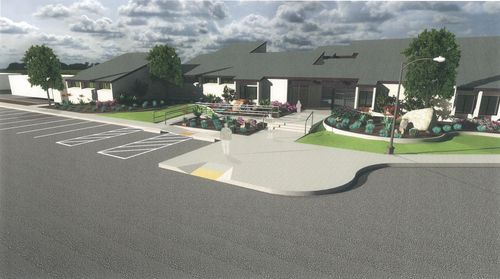
SHIPWRECK 12/8/22: Chula Vista’s Failure to add much-needed shelter. In May of 2020, The City of Chula Vista publicly announced its plans to add a shelter by using one of the Lucky Duck Foundation’s sprung structures, which can urgently provide temporary housing for 150 to 200 people experiencing homelessness. Tragically, after taking possession of this very valuable asset, they stored the shelter for more than 14 months. Ultimately the City of Chula Vista changed its mind and decided it did not want a bridge shelter, effectively preventing hundreds if not thousands of individuals from benefiting from the shelter while it was in storage. It wasn’t until more than two years later that the City actually broke ground on its shelter site. While a bridge shelter could have provided nearly 200 beds nightly, the City indicates it will open 66 pallet homes in January of 2023. Although this will help, taking more than 2.5 years to add 66 pallet homes is nowhere near the urgency or speed required to meaningfully address the region’s homelessness crisis.
SHAMROCK 12/8/22: Work for Hope (WFH) is a partnership between the McAlister Institute, Chula Vista PoliceDepartment, and Chula Vista Public Works Department to help individuals experiencing homelessness secure employment and housing by offering on-the-job training and work-training stipends to beautify city parks. WFH also includes wraparound services and case management to help link participants to addiction treatment, housing, and other critical services. It is the only collaboration of its kind in the country that pairs a nonprofit organization with both law enforcement and public works to provide individuals trying to overcome homelessness and addiction with hands-on training in specialized, transferable employment skills that range from commercial painting to landscaping and carpentry. WFH’s work crews have beautified every single one of Chula Vista’s City Parks (72 in total), including restroom repainting, signage upgrades, gazebo restoration, picnic area revivals, and weed abatement. Demand for the program far outpaces available openings and in only four years since its launch, 168 individuals have participated in the program and 147 have achieved long-term housing and employment. We encourage other cities to take note of this lifesaving and lifechanging program and consider implementing similar programs and partnerships.
Recent news coverage of WFH: Amid fentanyl threat, San Diego man helps people get off the streets and drugs (Spectrum News)
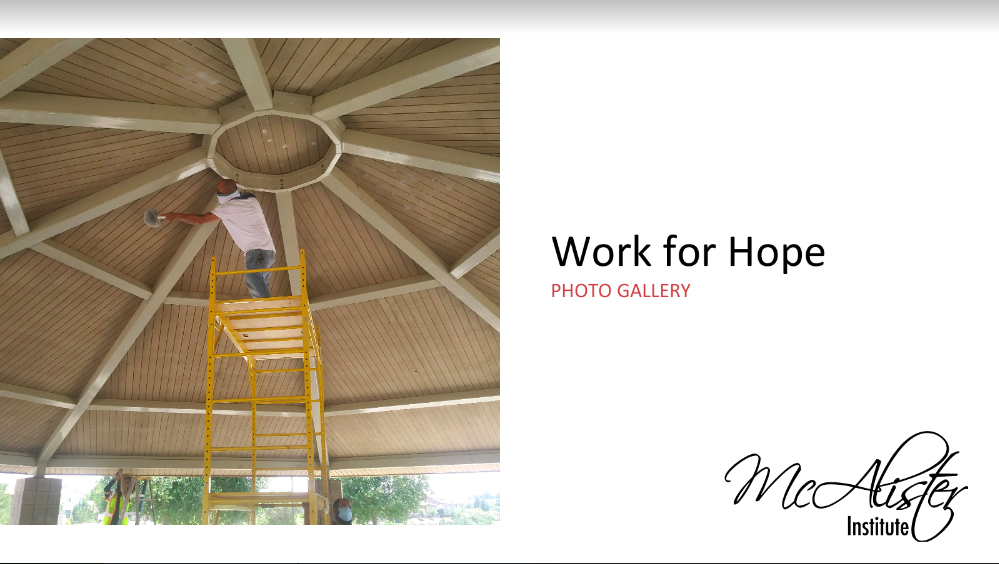
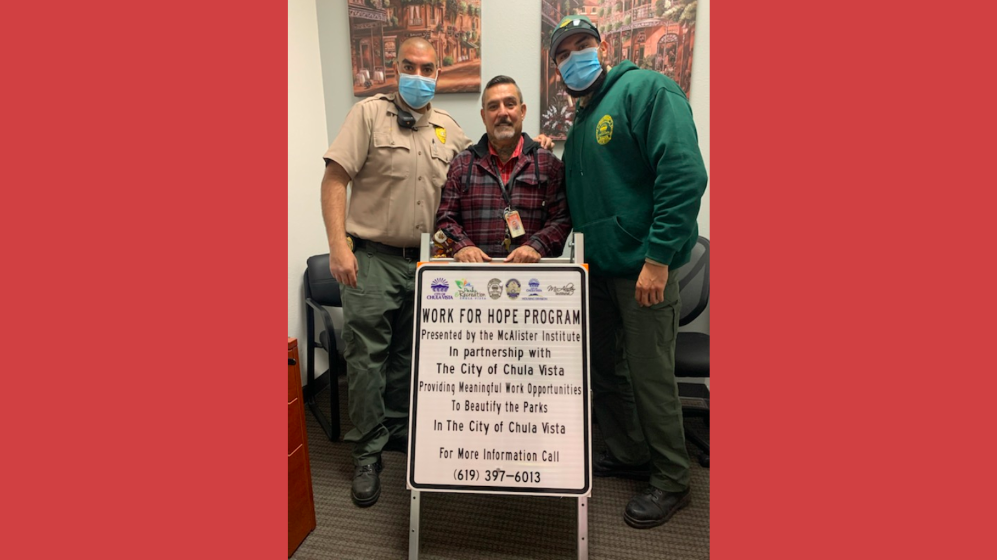
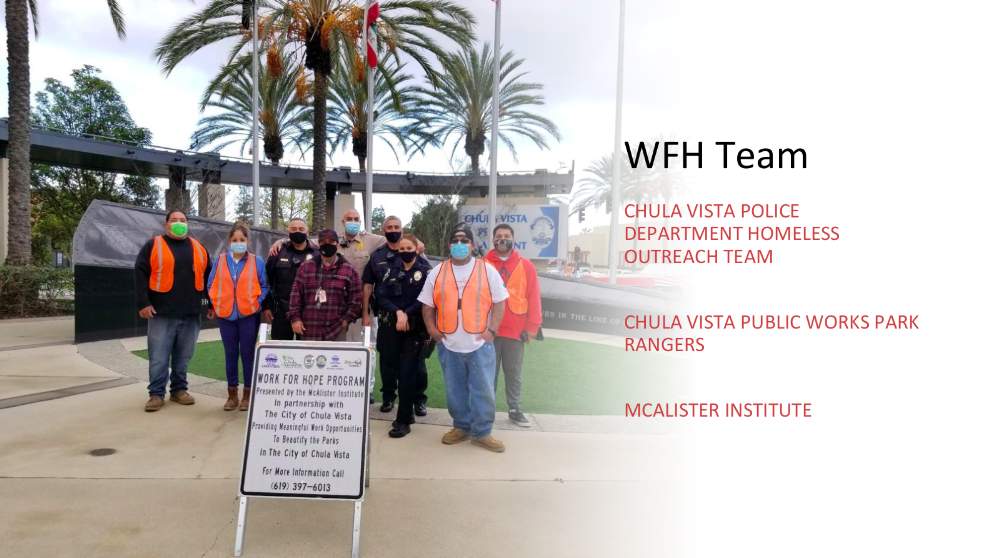
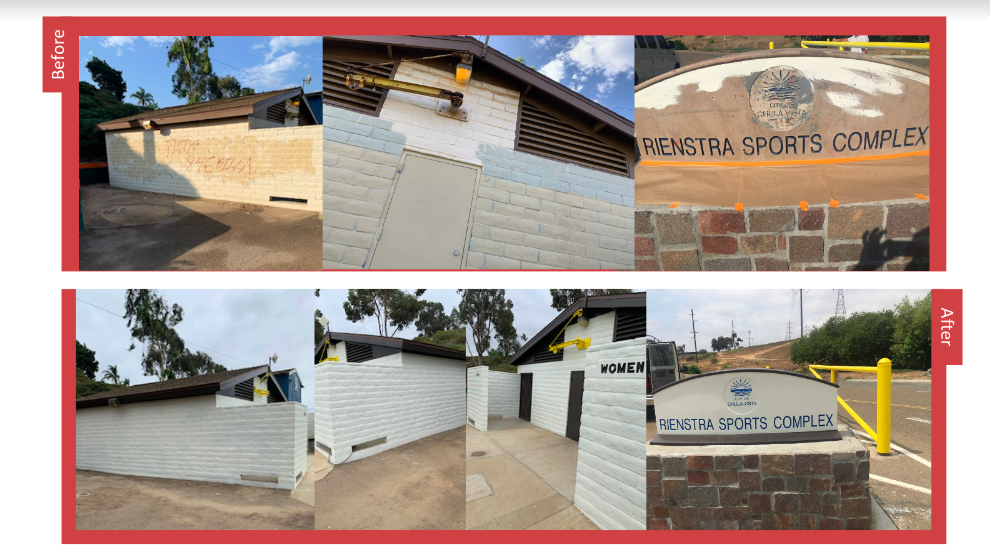
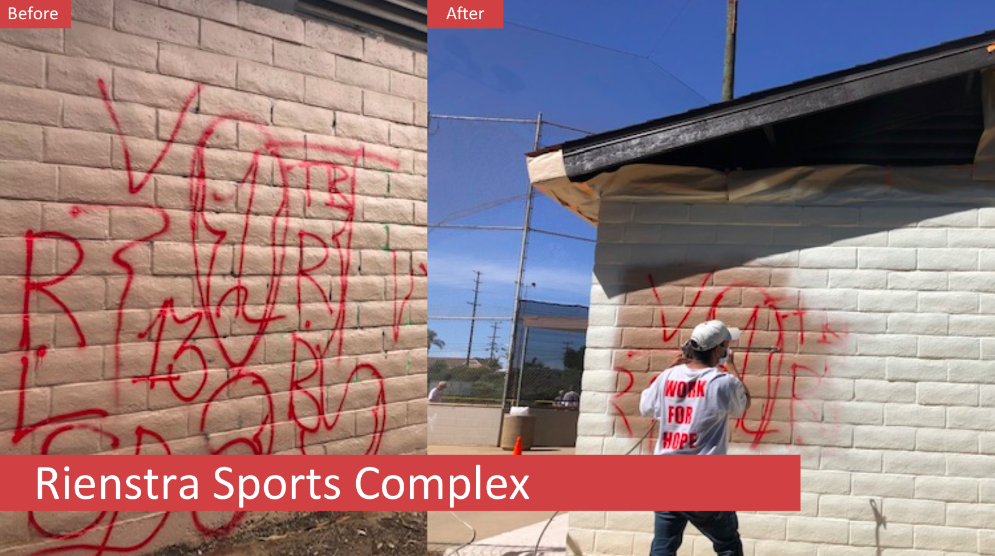
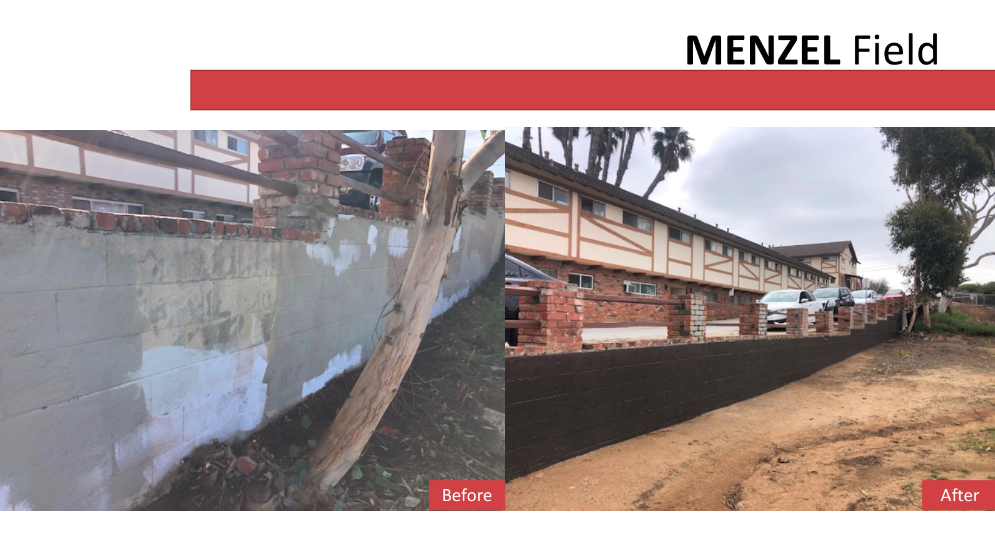
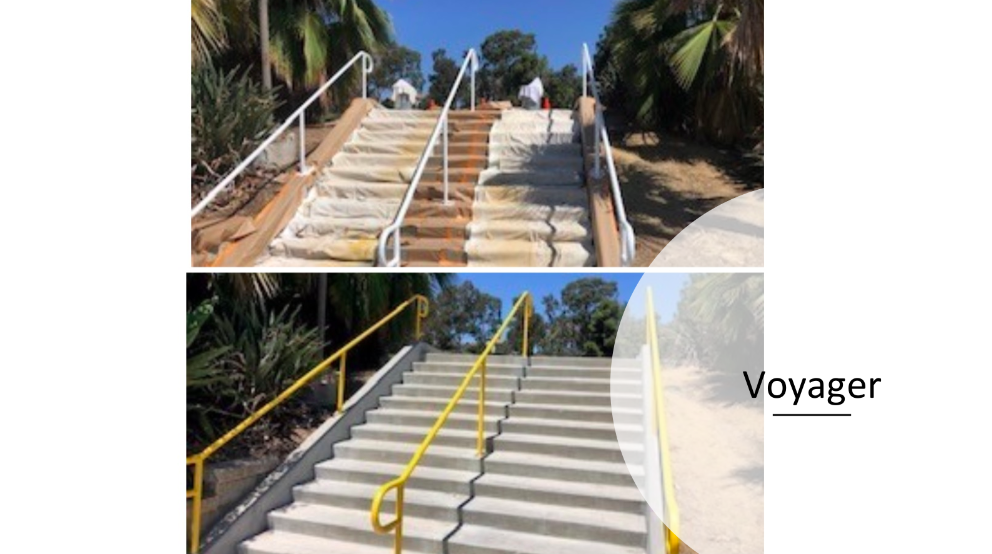
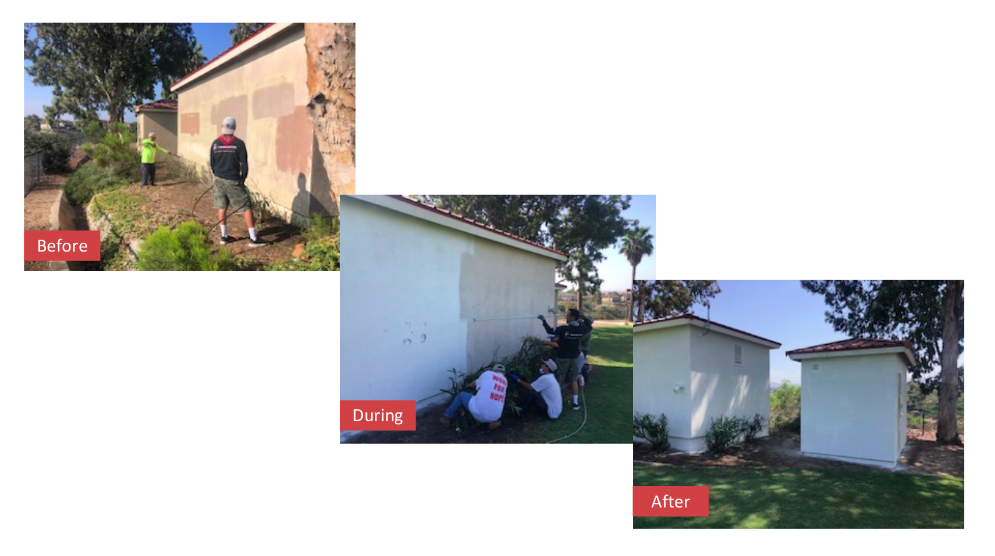
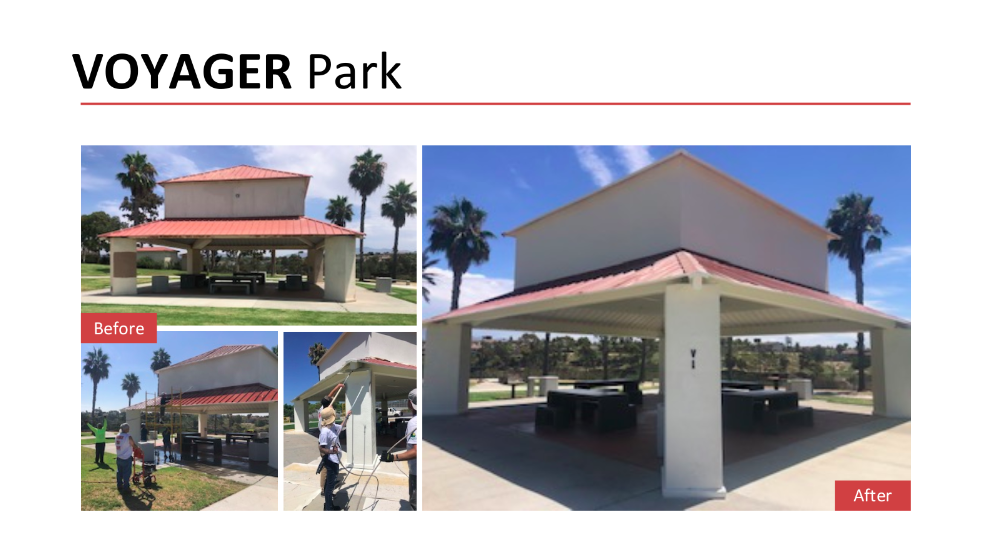
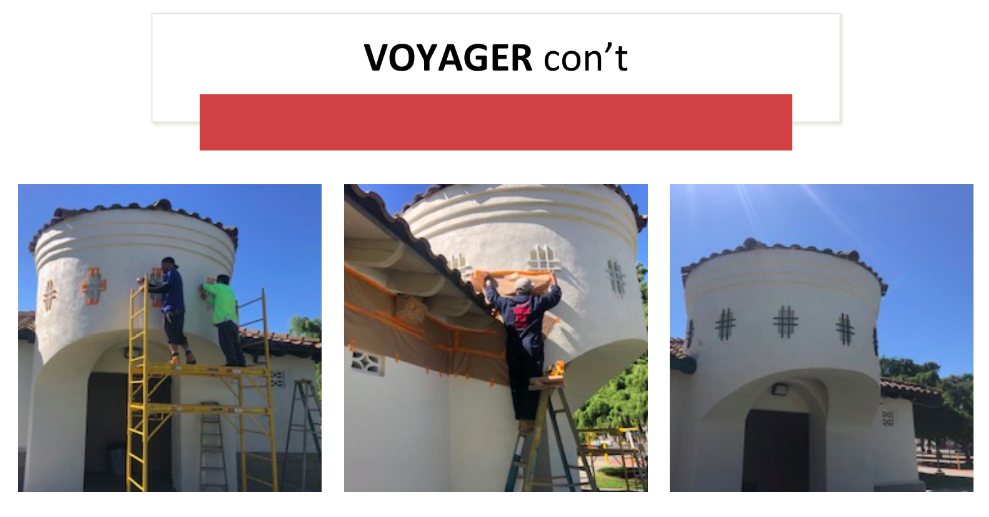
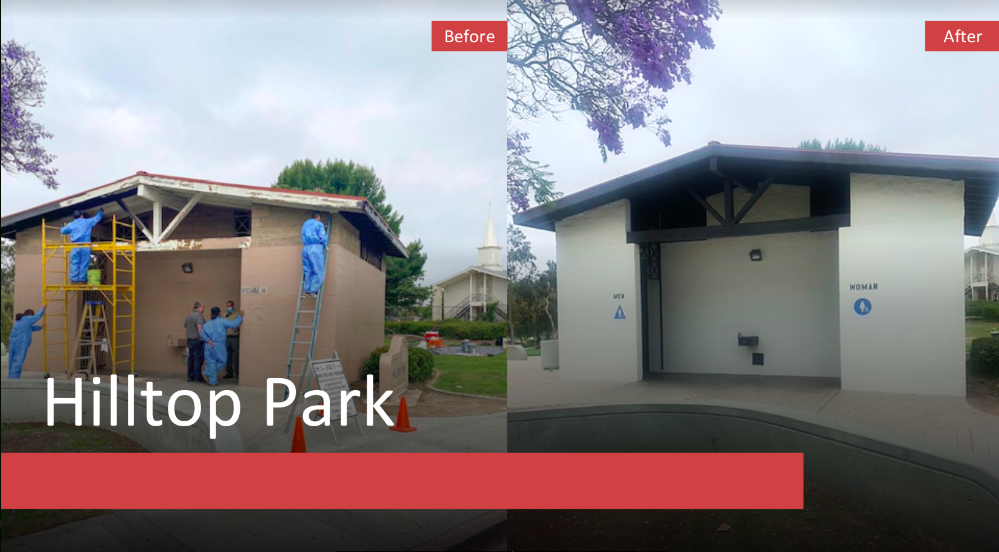
SHAMROCK 12/8/22: La Mesa’s youth homelessness collaboration. A once decrepit hotel in the city of La Mesa was generating more than 2 complaint calls per day to law enforcement about illegal and questionable activities including drugs and prostitution. New ownership renovated and then leased all 60 rooms to three different youth homeless service providers so that as many as 85 youth suffering from homelessness could have a safe place to stay. The service providers closely collaborate to manage the property and aid the youth, and the City of La Mesa has seen a significant reduction in complaint calls as well as youth homelessness. Additionally, the City of La Mesa is committed to supporting this model and looking to replicate it. Thus far the effort has helped 105 youth and led to permanent housing for 35 youth, with an additional 40 currently employed or in school. We applaud the hotel owner, City of La Mesa, Urban Street Angels, San Diego Youth Services, and Home Start for this collaboration which can be replicated elsewhere in the county.
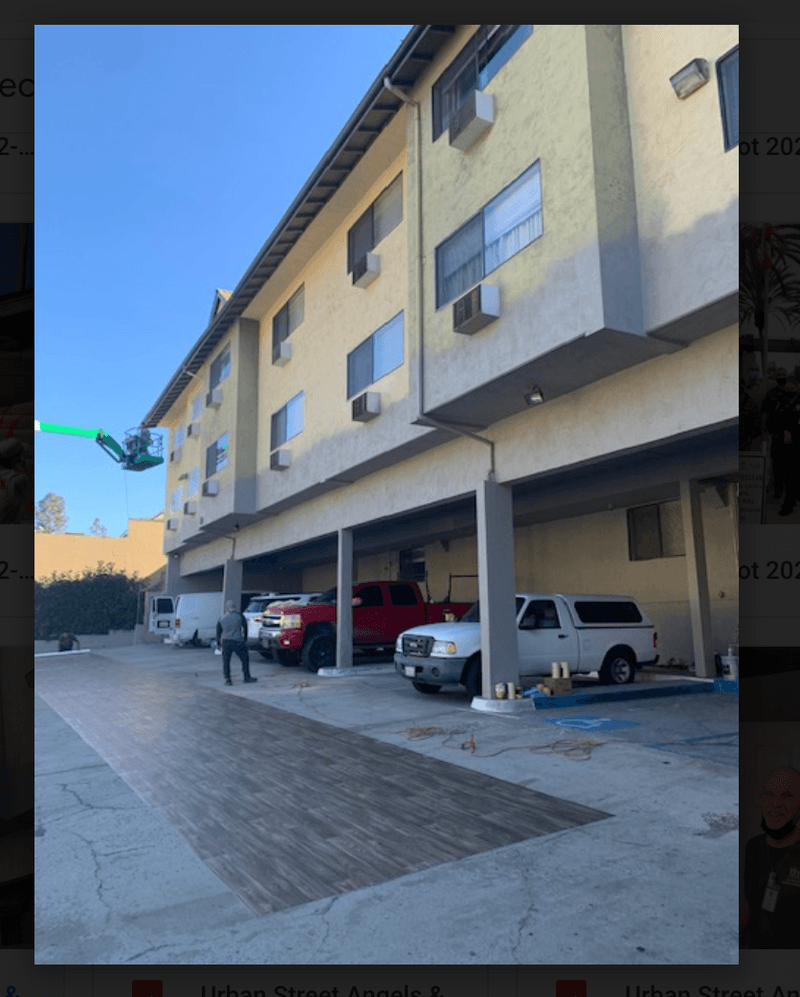
SHAMROCK 5/30/23: San Diego City Council, Mayor Gloria, County Board Chair Nora Vargas, County Supervisors Terra Lawson-Remer & Joel Anderson. For coming together to support the San Diego Housing Commission’s application for Homekey funding that if approved would quickly house 480 people currently living on the streets who are a growing percentage of seniors, youth, and individuals deemed as chronically homeless. This effort would provide immediately available beds coupled with supportive services from the County including mental health and addiction treatment. Additionally, Supervisor Anderson has asked the County to do a feasibility study of placing tiny homes at San Pasqual Academy to provide additional infrastructure for foster youth. This collaboration to pursue and deploy funding that is made readily available from the state specifically for the purpose of housing youth, seniors, and the chronically homeless is a constructive step and one strategy among many that must be implemented to start the process of reducing homelessness.
SHAMROCK 5/30/23: Mayor Todd Gloria and Councilmember Stephen Whitburn. For their proposed unsafe camping ban, which would make it illegal for encampments to be within 2 blocks of a school, homeless shelter, waterway, and some parks, regardless of whether any shelter beds are available. While we continue to urge law enforcement to protect innocent people from the criminal element and violent criminal behavior that revolves around the homeless population, this proposed unsafe camping ordinance is necessary to reduce encampments and unsheltered homelessness. It also reinforces the critical need for more immediately available beds, which we are prepared to help bring online as we’ve done in the past. That said, we applaud Councilmember Whitburn and Mayor Gloria for taking steps to reduce unsheltered homelessness and increase public health and public safety. To be clear, we do not in any way endorse the “criminalization of homelessness.” Rather, we fully support the City of San Diego’s ability to connect our homeless neighbors to lifesaving resources off the streets to reduce homelessness and protect public health and public safety. Should City Council not approve this proposed ordinance, we will reverse this shamrock to a shipwreck.
SHIPWRECK 2/21/23: After parents installed lights at a city-owned park so their kids could play softball after dark, the City of San Diego informed them they could not use the lights, even though the parents covered all costs to improve the city’s asset. It appears the city is more focused on removing safe and healthy opportunities for youth rather than focusing on removing the criminal element surrounding the homeless population. Few activities are more safe, healthy and enriching than competing in youth sports. Few things are more dangerous than failing to address the continued criminal behavior surrounding San Diego’s unsheltered homeless population. Additionally, in January, unsheltered homelessness in downtown San Diego reached an all-time high for the sixth consecutive month. The January count of 1,939 is nearly three times the number of people who were unsheltered in downtown only 2 years ago. Current efforts by the City of San Diego to provide lifesaving shelter is nowhere near the scale required to reduce homelessness. We urge the Mayor and City to treat this tragedy as the crisis that it is and significantly ramp up the shelter beds in the City. Reducing the criminal element by removing criminal behavior and the criminals who are committing crimes will immediately reduce the number of people on the streets while also protecting the public and those who are literally homeless, such as youth and seniors. We remain focused on providing strategies and funding to help the City of San Diego, the County and every other city throughout the region to reduce homelessness. However, removing opportunities for youth to participate in sports rather than removing the criminal element is, in our view, significantly missing the mark.
SHAMROCK 2/7/23: The County of San Diego and City of San Diego earned a shamrock for their support of Urban Street Angels to add 20 new immediately-available beds for youth experiencing homelessness. The County provided funds to cover construction and capital costs to make these beds possible, and the cost per bed to do so was economical. It was a solid investment. The City of San Diego, through the San Diego Housing Commission, is providing funding to operate the beds, meaning Urban Street Angels can provide supportive services and staff to help youth not only move off the streets, but also keep them off the streets by connecting them to education, employment, and housing opportunities to completely improve the trajectory of their lives. Maximization of the asset occupied by Urban Street Angels and this effective use of government dollars to add urgently-needed shelter beds for youth is exactly what should be done time and again throughout the County to reduce homelessness. And it should be done at scale so that significantly more than 20 youth can move off the streets once and for good.
SHIPWRECK 12/22/22: On December 21st about 4:30pm at the corner of 19th & Commercial, an individual outside of a large homeless encampment was wearing a bullet proof vest. He proceeded to chase people with a hammer. This incident occurred directly in front of the Youth Assistance Coalition, which aids hundreds of youth per year in overcoming homelessness. Law enforcement was called and arrived within 5 minutes but by then the individual had left on a bike. PD said at that point there was nothing they could do because the incident was over. The incident can be viewed here.
This type of behavior and threat of violent crime alone is a shipwreck. The fact it occurred within steps of the Youth Assistance Coalition is unfathomable. There is no reason youth who are trying to overcome homelessness should also have to deal with this type of violent and traumatizing behavior.
“This type of criminal behavior and lack of action to prevent and eliminate it is entirely egregious. What kind of society are we living in where someone on the streets is wearing a bullet proof vest and then starts chasing people with a weapon?” asked Dan Shea, Executive Committee Member of the Lucky Duck Foundation.
“Enabling street habitation and encampments supports and perpetuates this type of behavior. Unfortunately this is not the first occurrence outside of the Youth Assistance Coalition. A permanent police presence to prevent this type of behavior and to intervene immediately when these types of incidents occur is critical,” said Heather Lezon, Founder & Executive Director of the Youth Assistance Coalition. “Allowing people to stay on city streets is the beginning of the problem. I plead with the City of San Diego to protect our youth.”
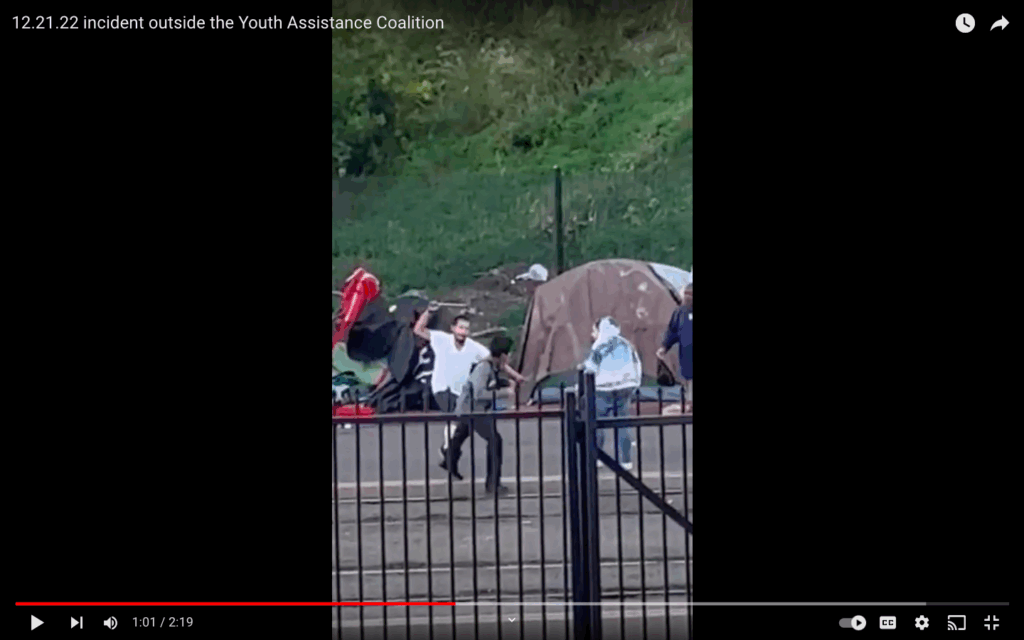
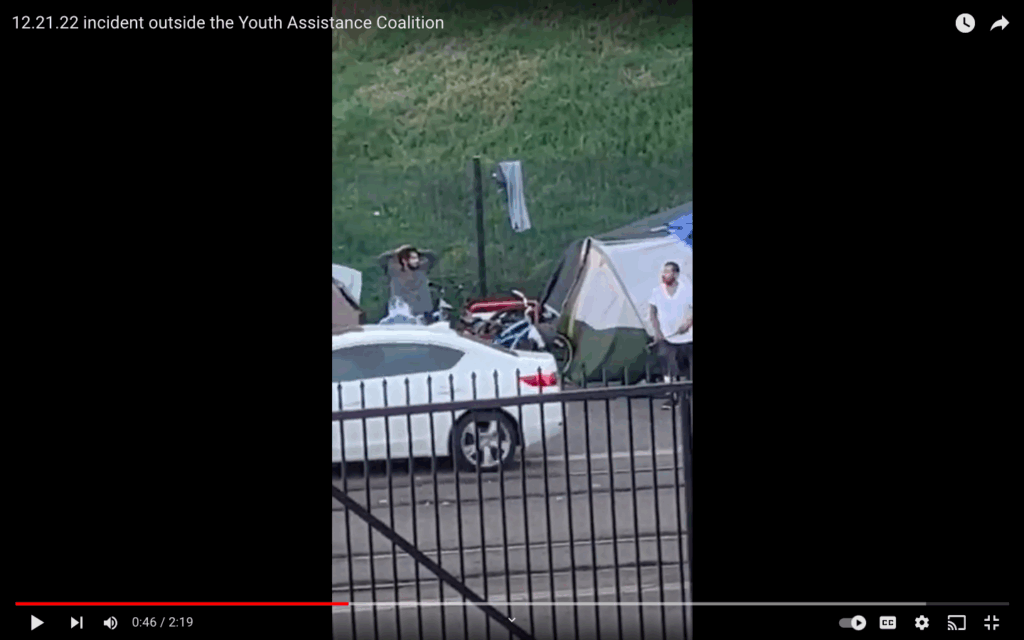
Screenshot from the video
Screenshot from the video
SHAMROCK 12/8/22: County of San Diego’s funding for shelters & the Cities who pursued it. San Diego County’s commitment to make $10 million available to all 18 cities throughout San Diego County to increase shelters provided much-needed funds to add urgently-needed beds. The cities of San Diego, Oceanside, and Vista pursued and secured these funds because of their plans to add immediately available beds. Additionally, because the County of San Diego made an underutilized parking lot available in the Midway District, a 150-bed mental health bridge shelter was opened in September of this year. Similarly, the city of Oceanside is converting a shuttered high school into a shelter. Activating underutilized government properties as these jurisdictions are doing is critical, cost-effective, and timely, and other cities and elected officials should follow suit.
SHIPWRECK 12/8/22: City of San Diego’s record-setting unsheltered homelessness. Since 2012, the Downtown San Diego Partnership has conducted a monthly count of unsheltered homeless individuals. During six of the last ten months, the count has reached new record highs, including an all-time high of 1,704 in November of 2022. Additionally, the count of homeless individuals on the streets of downtown has exceeded 1,000 people for 18 out of the last 19 months. The last time their count exceeded 1,000 people in a month was December of 2017, just ahead of the Hepatitis-A outbreak and crisis, which resulted in the deaths of 20 San Diegans. The sharp and ongoing increases in unsheltered homelessness in the heart of San Diego County is entirely unacceptable and has resulted in a public health and public safety crises. Downtown is arguably the epicenter of tourism, business, conventions, civic events and other activities and reducing homelessness and criminal behavior in this area is imperative for a myriad of reasons. A record-high alone is a shipwreck; record-high numbers in six of the last ten months is a tragedy and catastrophe of epic proportions. This sharp increase in unsheltered homelessness and subsequent illegal and dangerous activity has created daily unsafe and harmful circumstances for those who work, live or visit downtown. For example, the Youth Assistance Coalition is located downtown and aids hundreds of homeless youth every year who are trying to overcome homelessness. Instead, the youth they serve have been put in harm’s way due to limited public safety and sharp increases in unsheltered homelessness and criminal behavior immediately surrounding its building.
SHIPWRECK 12/8/22: Homeless deaths, drug & fentanyl use, and persistent criminal activity. Nearly 500 unsheltered people died on the streets in the last year, including 113 unsheltered people who died in San Diego City due to fentanyl overdose. Five years ago, the number of homeless fentanyl deaths was two. While the Executive order signed by San Diego Mayor Todd Gloria to provide stronger enforcement may help, the number of deaths and overdoses is heartbreaking and reinforces the need to provide significantly more immediate and lifesaving pathways off the streets. It also reinforces the critical need to have a coordinated plan and effort across local, state and federal organizations to dramatically improve our regions efforts to reduce homelessness. This includes meaningfully more shelter beds, compassionate but accountable intervention and enforcement along with urgently needed services. The enforcement must include efforts to reduce criminal behavior including but not limited to drug and sex trafficking and the use of fentanyl and other illegal and deadly substances. Although theCity of San Diego has said it intends to use the Old Library to add 25-30 beds, the City can’t “nibble” at the issue by adding only 25 to 30 beds when the old library can easily handle significantly more. Bureaucratic delays due to environmental reviews and other factors is akin to stating people are better off living on the streets.
SHAMROCK 5/23/24: In February, we issued a “shipwreck” to a local government agency after sending 9 siblings, all under the age of 18, out of safe care and onto the streets. This was due, in part, to a new law that had unintended consequences where technically the law was being followed, but, at the harm of putting children on the streets of San Diego. Regardless, the leadership and professionals at the County Department of Child and Family Well-Being took quick and compassionate action to find shelter for the young siblings, and all are now safely off the streets. As such, we are pleased to announce this shipwreck has become a “shamrock.” And, we hope all local government entities and service providers treat similar situations with equal urgency to protect our most vulnerable youth. We encourage you to watch this video which explains the issue in greater detail.
(UPDATED TO SHAMROCK, ABOVE) SHIPWRECK ISSUED 2/20/24: Polinsky Children’s Center and Child Protective Services are receiving a SHIPWRECK for sending a family of 9 children to the streets. Being between the ages of 2 and 17, these are the same children that these government organizations exist to help. Polinsky is deferring to CPS, while CPS has not filed a claim for two weeks while these children are seeking safe shelter and are being left to fend for themselves. This is a failure we feel needs to be publicized and rectified. San Diego must do better.
SHIPWRECK 5/30/23: County Supervisor Jim Desmond & Coronado Mayor Richard Bailey. For criticizing and ultimately saying “no” to the plan to pursue Homekey funding from the state to purchase nearly 500 housing units while not providing ideas or alternative strategies that would help people end their homelessness. It is much easier to say “no” than it is to develop a plan that will reduce homelessness. Sending unsheltered people to another city is not an appropriate or sustainable response for any city. Moreover, it places the burden and cost on other cities. Each of the 18 cities within San Diego County must do its fair share within its own city limits and budget to reduce homelessness and provide appropriate services and shelters.
Correction: a prior version of this Shipwreck stated that Mayor Bailey touts Coronado as having solved homelessness. While some media outlets stated that Mayor Bailey and Coronado had solved homelessness, Mayor Bailey has not corrected them but he has also not formally made this claim.
SHAMROCK 2/7/23: The County of San Diego and City of San Diego earned a shamrock for their support of Urban Street Angels to add 20 new immediately-available beds for youth experiencing homelessness. The County provided funds to cover construction and capital costs to make these beds possible, and the cost per bed to do so was economical. It was a solid investment. The City of San Diego, through the San Diego Housing Commission, is providing funding to operate the beds, meaning Urban Street Angels can provide supportive services and staff to help youth not only move off the streets, but also keep them off the streets by connecting them to education, employment, and housing opportunities to completely improve the trajectory of their lives. Maximization of the asset occupied by Urban Street Angels and this effective use of government dollars to add urgently-needed shelter beds for youth is exactly what should be done time and again throughout the County to reduce homelessness. And it should be done at scale so that significantly more than 20 youth can move off the streets once and for good.
SHAMROCK 12/8/22: County of San Diego’s funding for shelters & the Cities who pursued it. San Diego County’s commitment to make $10 million available to all 18 cities throughout San Diego County to increase shelters provided much-needed funds to add urgently-needed beds. The cities of San Diego, Oceanside, and Vista pursued and secured these funds because of their plans to add immediately available beds. Additionally, because the County of San Diego made an underutilized parking lot available in the Midway District, a 150-bed mental health bridge shelter was opened in September of this year. Similarly, the city of Oceanside is converting a shuttered high school into a shelter. Activating underutilized government properties as these jurisdictions are doing is critical, cost-effective, and timely, and other cities and elected officials should follow suit.
SHIPWRECK 12/8/22: City of San Diego’s record-setting unsheltered homelessness. Since 2012, the Downtown San Diego Partnership has conducted a monthly count of unsheltered homeless individuals. During six of the last ten months, the count has reached new record highs, including an all-time high of 1,704 in November of 2022. Additionally, the count of homeless individuals on the streets of downtown has exceeded 1,000 people for 18 out of the last 19 months. The last time their count exceeded 1,000 people in a month was December of 2017, just ahead of the Hepatitis-A outbreak and crisis, which resulted in the deaths of 20 San Diegans. The sharp and ongoing increases in unsheltered homelessness in the heart of San Diego County is entirely unacceptable and has resulted in a public health and public safety crises. Downtown is arguably the epicenter of tourism, business, conventions, civic events and other activities and reducing homelessness and criminal behavior in this area is imperative for a myriad of reasons. A record-high alone is a shipwreck; record-high numbers in six of the last ten months is a tragedy and catastrophe of epic proportions. This sharp increase in unsheltered homelessness and subsequent illegal and dangerous activity has created daily unsafe and harmful circumstances for those who work, live or visit downtown. For example, the Youth Assistance Coalition is located downtown and aids hundreds of homeless youth every year who are trying to overcome homelessness. Instead, the youth they serve have been put in harm’s way due to limited public safety and sharp increases in unsheltered homelessness and criminal behavior immediately surrounding its building.
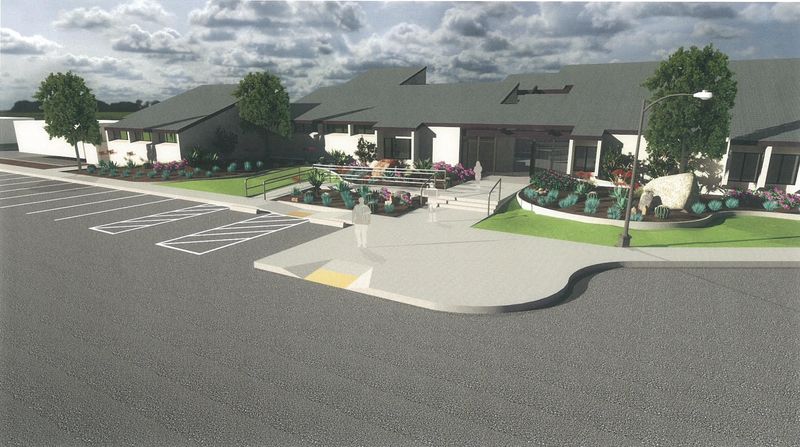
When you subscribe to our newsletter, we will donate a pair of Bombas Socks* on your behalf.
*Socks graciously donated by our collaborative partner, Bombas Socks.
